Apple iPhone 13 Pro review

Small Pro, same big camera update
There are no differences this year - the iPhone 13 Pro is treated to the same camera setup as the 13 Pro Max, meaning you no longer have to go big to get the best imaging hardware Apple is offering. And it's the 'biggest camera update ever on an iPhone' too, as Apple is keen to point out.

The list of upgrades starts with an improved main (or 'wide') camera on the back, which gets a larger sensor with big 1.9µm pixels. The 12MP sensor itself is stabilized (as was on the 12 Pro Max), and the optics inside the 26mm-equivalent lens with an f/1.5 aperture only need to move for focusing.
The telephoto has gained some extra reach - to a 77mm equivalent or 3x zoom, up from 2x on the 12 Pro and 2.5x on the 12 Pro Max. It has lost some lens power in the process, and the aperture now is f/2.8 instead of f/2.2. The lens is still stabilized, and the sensor is still 12MP.
The ultrawide doesn't need stabilization all that much, but what it did need, it got - autofocus, which also lets it take close-up shots. In addition to that, its lens is also brighter, boasting an f/1.8 aperture (up from f/2.4). As with all other sensors, this one is 12MP.
There's also a LiDAR scanner which assists the main and portrait cameras with detailed depth maps for portraits and faster autofocus in low-light conditions.
There are no upgrades on the front, and the selfie camera remains at 12MP with a 23mm focal length and an f/2.2 aperture lens. There's no autofocus here, unfortunately. The structured light 3D scanner for FaceID also helps out for Portrait mode.
Camera app and features
The camera interface is mostly unchanged since iOS 13 and the iPhone 11. You swipe left and right between modes and have a couple of settings you can uncover with an upward swipe - flash, night mode, live photo, photo aspect, exposure compensation, and filters. In video mode, you can change the resolution and frame rate from the viewfinder.
It's from this interface that you can access the new feature called Photographic Styles. You get Standard, Rich Contrast, Vibrant, Warm, and Cool, and these apply tonal and color corrections, which you can fine-tune with the two available sliders.

Another new 'feature' is the ability to take close-up shots. Enabled by the ultrawide's camera newfound autofocusing capability, it's an option you only get on the iPhone 13 Pro and Pro Max, but not on the non-Pros.
That comes with a potentially infuriating side effect that the phone will quietly switch from the main to the ultrawide when you go below the main camera's minimum focus distance threshold while maintaining the main camera's field of view - upscaling and all that. Apple has allegedly promised they will add the option to turn off this behavior with an update later this fall, and it can't come soon enough.
Daylight image quality
All the camera updates on this year's Pros haven't brought about drastic changes in image quality and overall 'feel' - these are very iPhone photos we're looking at. That means they're not overly exciting in terms of color - natural is the operative word here, though some may use more expressive terms. They're not overtly HDR-y either - iPhones aren't afraid of clipping some of the highlights or underdeveloping the deepest shadows if it's needed to get that characteristic contrasty look.
Detail is no different than any of the 12MP cameras on the market - it's plenty. There's hardly any noise to speak of, but not everyone will be a fan of the somewhat overprocessed rendition of intricate detail that outresolves the sensor.












Daylight samples, main camera (1x)
The newly introduced Photographic Styles feature allows you to alter that default iPhone look to your liking. Here's a comparison between the 5 available presets (effectively the default plus 4 more).




















Photographic styles: Standard • Rich Warm • Vibrant • Warm • Cool
The 3x telephoto doesn't disappoint and gets you high-quality images. Sharpness and detail are excellent, noise is kept in check. There's wide dynamic range and good contrast in these shots, and the colors are in line with the conservative but likeable rendition of the main camera.





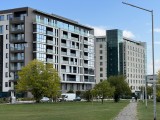


Daylight samples, telephoto camera (3x)
The ultrawide camera is generally up to the same high standard maintaining the global look in color rendition and dynamic range. It does leave a little to be desired at 1:1 magnification, where it's not quite as crisp as the other two, but it's easily good enough for an ultrawide.








Daylight samples, ultrawide camera (0.5x)
The ultrawide's newly added autofocusing capability means you can now use it to emphasize perspective and show how subjects relate to their environment.



Daylight samples, ultrawide camera (0.5x)
Macro
That AF on the ultrawide also lets you get right into your subject while still keeping things sharp, making for some striking close-up shots.
The extremely close focusing distance combined with the large aperture make for a razor-thin depth of field. With the added effect of field curvature, which means that the focal plane is curved like a bell, you'll likely not get everything you want in focus, but with good technique and practice, you should get some nice 'macro' photos.
Low-light image quality
The iPhone 13 Pro's Auto Night mode on the main camera will deliver excellent low-light images, though not quite as Night mode-y as other makers' Night modes. There's no dramatic highlight restoration or shadow brightening, and it's instead a more contrasty look, closer to what your eyes are seeing, some say.
White balance and color saturation are really good, and we seemed to experience less of the orange cast we saw on the Pro Max with certain street lights.
Detail is very good unless you look for it in the extreme shadows or highlights, where Apple's tonal curve might leave you wanting.











Low-light samples, main camera (1x), Auto Night mode
Manually turning off Night mode will dial down the saturation slightly and will also make shadows a little darker still. These aren't a dramatic difference, however, and we'd keep Night mode enabled.











Low-light samples, main camera (1x), Night mode off
At the 3x zoom level, the iPhone 13 Pro will still revert to its primary camera if it deems the scene is too dark. There are also instances when a Night mode photo will be taken by one camera and the non-Night mode - by another, with Night mode generally being more likely to get you the tele.
Overall, the images are decent, but nothing remarkable. Night mode will get you better images with good detail and sharpness, particularly in reasonably well-lit scenes. In scenes where it wouldn't trigger, it pays off to enable it manually by pushing the slider to the Max position. In any case, a boost in exposure wouldn't hurt these.








Low-light samples, telephoto camera (3x), Night mode
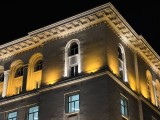



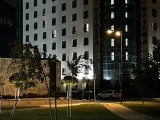
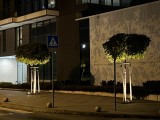
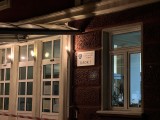

Low-light samples, telephoto camera (3x), Night mode off
The ultrawide camera of the iPhone 13 Pro does a respectable job for what isn't all that impressive hardware in the context of low-light shooting. Photos taken in Night mode have good sharpness and detail as ultrawides go, and if you (like us) aren't a fan of the default exposure, you could try maxing that Night mode slider. The colors are accurate, dynamic range is okay.
Switch off Night mode and may lose a lot of the deeper shadows entirely, with saturation taking a hit as well. We'd definitely shoot in Night mode on the ultrawide and make an effort to push it manually for those instances when the phone wouldn't.








Low-light samples, ultrawide camera (0.5x), Night mode








Low-light samples, ultrawide camera (0.5x), Night mode off
Once you're done with the real-world samples, head over to our Photo compare tool to see how the Apple iPhone 13 Pro stacks up against the competition.



Apple iPhone 13 Pro against the Galaxy S21 5G and the Oppo Find X3 Pro in our Photo compare tool
Portrait mode
Portrait mode on the iPhone 13 Pro works with either the main or the telephoto camera. The pros of each are well known - the main camera will get you higher quality images in all situations, but especially in low light; the telephoto lets you stand further back from your subject and has a more 'portraity' perspective - and the cons are the opposites.
Outside of the occasional blurred shoulder, subject separation is typically very good on the main camera. We're getting pleasing skin tones with a bit of warmth courtesy of the phone. Detail is great, and dynamic range is excellent too, in virtually all conditions.
The telephoto camera isn't on the same level in terms of detail, even in broad daylight, and might make the occasional small mistake along the border between the subject's clothes and background. Still, it will get you a vastly superior perspective. Nothing but praise on dynamic range and colors again.
Selfies
The selfie camera is similarly great for shooting people, as it is, after all, its main purpose. While in general photo mode, it will return slightly less saturated colors, skin tones remain likable. Exposure and dynamic range are once again superb, resolved detail is excellent, and the noise is unobtrusive.
The default field of view for selfies is a cropped in 7MP version when you're holding the phone in a vertical orientation, but you can enable the full view with a tap, and the phone will also auto switch to that if you're shooting horizontally.
Portrait mode on the selfie camera is only available in that 7MP view and comes with a slight saturation boost and a bit of extra warmth. The subject separation is aided by the FaceID hardware making for some impressive results.
Reader comments
- Sanish
- 08 May 2025
- 6kx
13 pro the Best iphone ever👌👌
- Anonymous
- 19 Apr 2025
- raQ
Yes. I'd highly recommend the 13 pro as you can find many great deals on it with tons of storage. Still competes with the latest iPhone at a fraction of the price! Hope you enjoy your new phone!
- AVerifiedPig
- 02 Apr 2025
- Lcd
I'm upgrading from a 6s. I can get a 13 Pro for under 500€ with a new battery but reconditioned. Worth it?








































